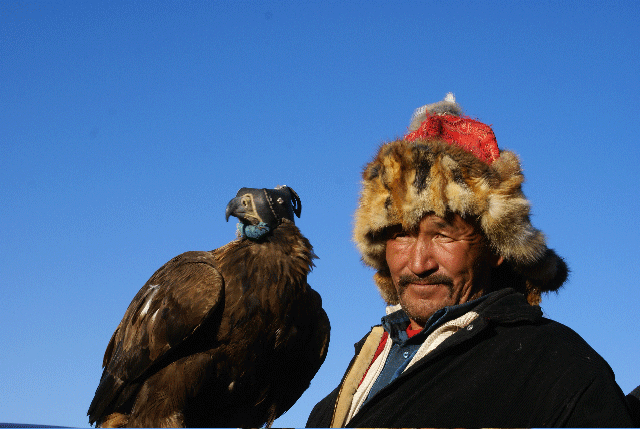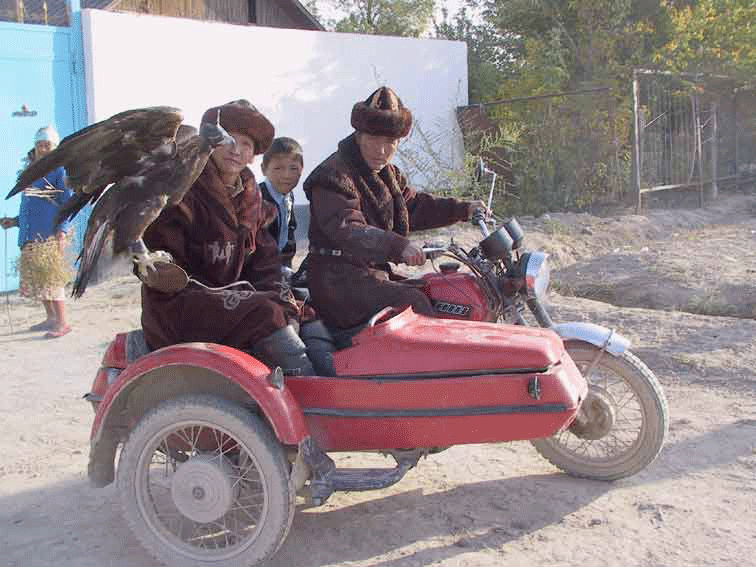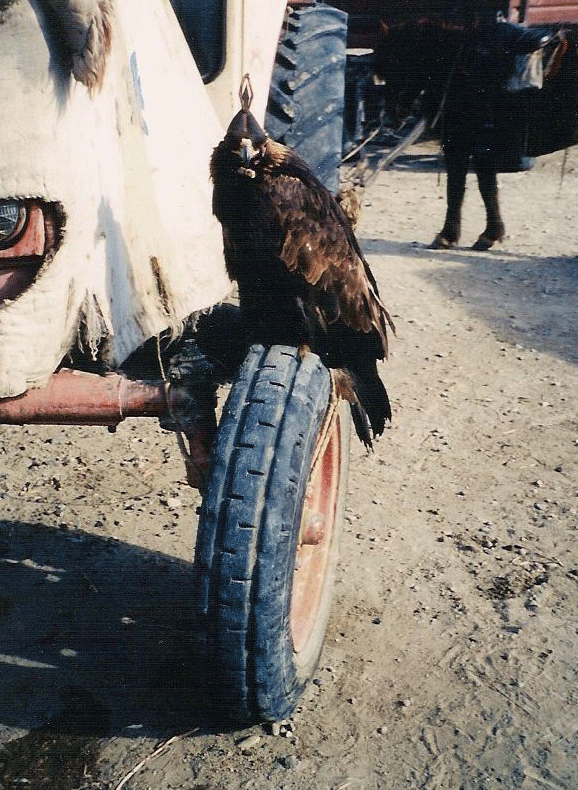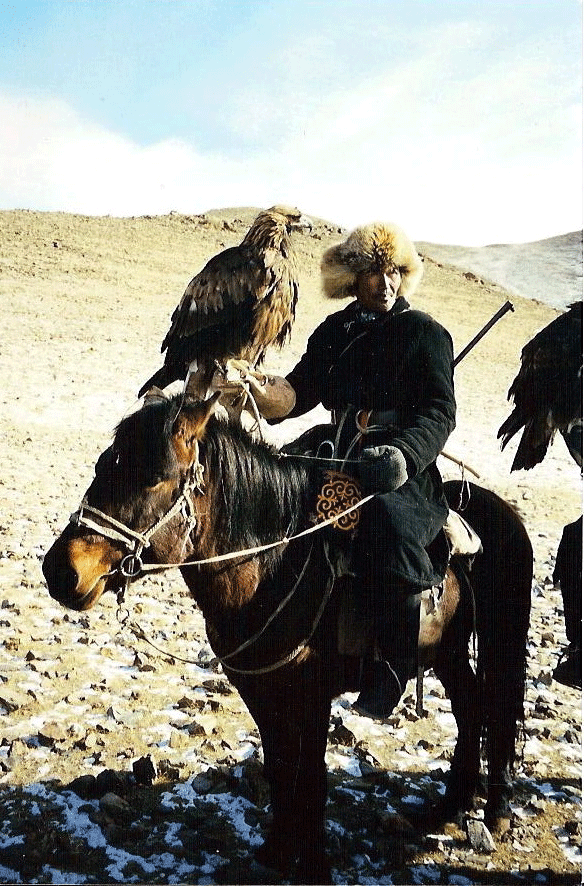Eternity of Eagles
Air Date: Week of October 26, 2012

(Photo: Cat Urbigkit)
Stephen Bodio is a naturalist, falconer, and writer whose travels have taken him all around the world. During the 1990s, he lived with Kazakh tribes of central Asia, who use eagles to hunt wolves. Bodio discusses with host, Steve Curwood his new book a compendium of all things eagle called An Eternity of Eagles.
Transcript
CURWOOD: Although Benjamin Franklin thought the turkey would make a better national emblem for the United States, we wound up with the Bald eagle - hardly a surprise, as eagles have fascinated and inspired humans throughout history.
Nature writer Stephen Bodio fell under their spell - his new book details the complicated place of eagles in a variety of human cultures. The richly illustrated work called "The Eternity of Eagles" takes us from central Asia where the Kazakh tribes use eagles to hunt wolves, to the American West where herders once shot them from aircraft to protect their flocks. Steve Bodio joins us from Albuquerque, New Mexico. Welcome to Living on Earth, Steve.
BODIO: Glad to be here!
CURWOOD: So, tell me, what makes an eagle, an eagle? I mean, is this just a name or is there some real biological distinction between eagles and the other birds of prey… I’m thinking of goshawks, and harriers, all kinds of birds of prey.
BODIO: The word eagle covers 80-odd species, depending on your taxonomy. We use it in English to mean a number of things – almost more cultural than biological – large bird of prey. We also call various things eagles that might be better called harriers or hawks or giant kites or something completely unique.
On the other hand the truest eagles, the Aquila eagles, the animals we first called eagles, and their relatives, are a very distinct bunch of large, intelligent, active predators, usually with feathered legs. They’re biologically related birds, you know, a natural evolutionary group. So, there’s the essential eagle and there’s the broad constructed concept eagle.
CURWOOD: So, what’s your favorite eagle?
BOLIO: My favorite eagle is the Golden Eagle. That’s the eagle that really is eternally, metaphorically with our culture. It is a hunter, an intelligent bird, a bird that has been trained very early by human cultures as a useful and interesting companion. It can live on young herons in the Maritimes or on turtles in Greek islands. It was the Roman war eagle, it was the symbol for that. An enemy to some cultures and a friend to others. It is a universal eagle, I think.

Going hunting outside Nura Village, near Charyn Gorge, Kazakhstan, on Russian motorcycle. (Photo: Wolfgang Regar)
CURWOOD: What is one of your favorite eagles that we may not have heard of?
BOLIO: Favorite eagle you may not have heard of, which is barely an eagle but has the name, is the Bateleur of Africa, which is related to the group called snake eagles, but resembles a flying wing. It has almost no tail, huge wings.
In the skies of southern and eastern Africa, there’s always one up, almost like the redtails soaring in the east or turkey vultures in the west, except it’s moving like some sort of science fictional airplane, barely beating its wings but it’s going by at about 60 miles per hour. Rocking slightly on the wind. They cover hundreds of miles per day with barely a flap and they’re very pretty in an exotic way.
CURWOOD: Steve, now, you’ve spent a great deal of time in central Asia, please describe for us how people use eagles to hunt there… and I understand they hunt for wolves?
BOLIO: They hunt for wolves. Their day-to-day hunting is probably more for fur animals and for some food animals. Fox is probably the most popular quarry, and that’s very easy, that’s just like a hawk catching a rabbit once they learn how to do it. But wolves are an important stock predator in central Asia and most people don’t have firearms, certainly didn’t have them until the fall of the Soviet Union and an eagle is capable of killing a wolf.
The eagle flies in, quickly grabs the wolf by the muzzle to immobilize its teeth, which are its only weapon, really unlike a cat, and grabs it by the neck or breaks into the chest with its incredibly powerful foot, and basically has it opened in a minute or two – its large blood vessels opened – and kills it very efficiently.
CURWOOD: What brought you to central Asia?
BOLIO: A lot of romantic travel people fixated on Africa or on South America, and for some reason I was fascinated with Central Asia from the get-go. I saw a picture of what I now know was a Kazakh herdsman in some magazine when I was about five in Boston.
And the guy was wearing the clothes of a snow leopard and had an eagle on his fist and I just fixated on this and said to myself, not even consciously… I need to see that, I need to go there. And after the Soviet Union fell, I immediately started making queries of friends I knew that traveled… have you seen eagles, have you seen Kazakhs, have you met Kazakhs?
I met a really interesting couple in Brooklyn in Brighton Beach who showed me films of eagles and wolves and got contacts and eventually flew out in February… mid-winter, I wanted to be able to see some hunting, it turned out to be a little late in the season, but better than too early, into Ulaanbaatar, into a night of 40 below zero and then 600 more miles without pavement to Bayan Olgii, the Kazakh state of Mongolia, and a day later I was looking at a hunting eagle perched on a truck tire and knew I had arrived.

A Kazakh eagle, perched on a tire of a truck in Bayan Nuur outside of Olgii city. Photo: Steve Bodio)
CURWOOD: (Laughs.) On a truck tire, huh?
BOLIO: On a truck tire. One of the amusing things, wonderful things of central Asian eagle culture, it’s incredibly pragmatic. Tire makes a great perch, certain synthetics make interesting jesses’ materials, modern sort of high tech outdoor clothing is warm and can be worn underneath your traditional fur robes, and why not? And they’re still doing something they’ve been doing for thousands of years and are happily making use of modern technology. One of the fun photographs in there is a bird riding in a side car of a Russian motorcycle going up and down the streets!
CURWOOD: Now, tell me, how do the Kazakhs train these eagles that they use to hunt?
BOLIO: The taming is merely familiarizing. The Kazakhs do one particularly odd thing, they put the bird on what looks like a hammock rolled up - tethered at both ends, and it’s sort of a swinging perch, hooded, to make it have to constantly be changing its grip and a little off-base while they gradually expose it to humans, to children, to dogs, to horses, and to food.
And they feed the bird, which I find interesting, off the point of a knife or out of a bowl rather than their fingers so it’s obviating being bitten or snatched easily. The taming goes like that. And eagles are very intelligent, like most birds of prey, and even as adults tame down really fast.
After each of those training processes, you simply teach, think of teaching a dog… you teach the bird to come when it’s called… here’s the food, whistle, whistle, here’s the food, come on…come on, boy. Or, actually, mostly girl, because, one thing that we haven’t touched on but is commonplace in the bird of prey people - female birds of prey are larger and stronger than the males, almost inevitably.
The more predatory the species, the more likely this dichotomy. Very few males are trained by the Kazakhs, and when I once asked an older Kazakh, perhaps blunter than my friends of my own age, if he ever trained a male and he said ‘do I look like I hunt mice?’
CURWOOD: (Laughs.) So, what was it like to ride with the Kazakh eagle tribes?
BOLIO: Completely delightful, they’re the most hospitable people in the world. I could not ride all day, and all day and as fast as these people could. I mean, I didn’t grow up on horseback. But you’d go out in this freezing weather and go out over hill and rock and ice and very little vegetation, just looking for the flight of the fox and you learned to really appreciated boiled mutton and hot tea with butter in it and shots of vodka by the time you came back to the house – as they called their winter-spending place, their adobe houses. I’ll do it as long as I can afford and walk.
CURWOOD: Now, currently, what are the major threats to the world’s eagles?
BOLIO: Habitat destruction. And of course the unknown consequences of climactic change. If an eagle has a very small habitat, an island habitat or a marginal habitat, a change could make it very difficult. And I think our classical eagle, our Golden, is not under danger to thrive, it’s likely to outsee our species if we don’t wise up.
But some other eagles with small ranges or threatened habitats – those are the ones that I really worry about. Also, a peculiar, very ambivalent threat, ambivalent in the sense that we are trying to do it for good reasons – wind farms are a real problem for eagles. They’re supposed to be clean energy, but I wonder if the ecological costs of such things on bird populations might be more than we would be willing to pay if we understood them.
CURWOOD: Let’s talk about the future of the eagle. No, better yet, let’s have you read from the very end of your book, the last paragraph that you have.
BOLIO: Sure. ‘Eagles will continue to be eagles, splendid, and for the most part, indifferent to our ways. Some of us will always be obsessed with them: love them, hate them, make art or friends of them. They don’t care. They ask nothing but to go on their splendid old dinosaurian way, over our heads, in or out of our minds. They need us less than we need them.

The parade at the annual (September) eagle festival in Olgii. (Photo: Cat Urbigkit)
If we leave them a space, they cannot live in cities (though balds may yet); they may outlive our restless species, as they pre-date us. If they don’t, we may find that many eagles may vanish, leaving only the eagles of the mind that we’ve created in their image. We will be the poorer for it, but I confess, I doubt it will ever happen.

I suspect it’s more likely that Aquila will pass like a shadow over the last human ruins, casting a benign predator’s glance at them as she hunts on down the wind.
CURWOOD: Stephen Bodio is a writer, naturalist and falconer from New Mexico. His latest book is called: An Eternity of Eagles: The Human History of the Most Fascinating Bird in the World. Thanks so much, Steve!
BODIO: Thank you - this was fun!
Links
Living on Earth wants to hear from you!
Living on Earth
62 Calef Highway, Suite 212
Lee, NH 03861
Telephone: 617-287-4121
E-mail: comments@loe.org
Newsletter [Click here]
Donate to Living on Earth!
Living on Earth is an independent media program and relies entirely on contributions from listeners and institutions supporting public service. Please donate now to preserve an independent environmental voice.
Newsletter
Living on Earth offers a weekly delivery of the show's rundown to your mailbox. Sign up for our newsletter today!
 Sailors For The Sea: Be the change you want to sea.
Sailors For The Sea: Be the change you want to sea.
 The Grantham Foundation for the Protection of the Environment: Committed to protecting and improving the health of the global environment.
The Grantham Foundation for the Protection of the Environment: Committed to protecting and improving the health of the global environment.
 Contribute to Living on Earth and receive, as our gift to you, an archival print of one of Mark Seth Lender's extraordinary wildlife photographs. Follow the link to see Mark's current collection of photographs.
Contribute to Living on Earth and receive, as our gift to you, an archival print of one of Mark Seth Lender's extraordinary wildlife photographs. Follow the link to see Mark's current collection of photographs.
 Buy a signed copy of Mark Seth Lender's book Smeagull the Seagull & support Living on Earth
Buy a signed copy of Mark Seth Lender's book Smeagull the Seagull & support Living on Earth

